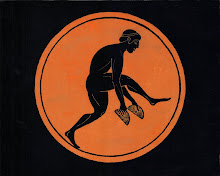Monday, November 22, 2010
Restoring the Horse 2010
It was a glorious day in San Francisco; one of those memorable, typically autumn, sixty-something degrees, with no wind blowing, days in Golden Gate Park.
Thomas Sperow has finally had the opportunity, after a busy year and despite economy slow-down and remodel pull-backs, to return to his beloved, charitable project of restoring Vet Anderson’s WPA horse bas-relief sculpture (c . 1937) in Golden Gate Park’s Horseshoe Courts. In July 2010, the scaffolding was erected in front of the horse bas-relief in order to commence restoration work on it. I’ve included photos of several views of the horse dated both Sept 2009, and Nov 2010; you can make your own comparisons of how much more damage has occurred.
Unfortunately, it looks like vandals decided to use the erected scaffolding for their own defacing motives. The horse has been neglected for too long and it just seems to get worse with that one-step forward, two-steps back feeling looming about. The friable horse sculpture has once again been effaced. The muzzle, the ear and the eyes have been spray-painted an electric green. The horse’s face actually looks very sad now as a result of the inept deface artist’s feeble attempt of artistic expression.
Additionally, we found several large pieces of the sculpture that have either crumbled off naturally as a result of weather, tree roots and other variables that add to the overall decay of this splendid sculpture or they’ve been torn off for kicks by vandals. We also found the ubiquitous syringe near the scaffolding.
The horse sculpture is very friable. The restoration of this sculpture will have to go in stages. Luckily this drilling was done several days before the rains arrived that have graced Mother Earth—we always need rain. Tom spent the day drilling in two stages: First Tom drilled 5/8 in. x 10 in. pilot holes followed by coring with a 1 in. carbon-tipped drill bit. The cored holes were cleaned of debris and immediately after, HILTI epoxies were injected into the holes drilled and ¾ in. stainless steel rods were inserted into the cored holes. The steel rods will serve as the foundation for the frame that will be built to recreate the belly cavity of the horse bas-relief. Fourteen (14), in total, stainless steel rods were used instead of re-bar because they will not rust; it is imperative to use materials that will benefit the conservation of what remains and anchor the restoration moving forward. -photos and post by Ingrid Sperow
Subscribe to:
Post Comments (Atom)


No comments:
Post a Comment